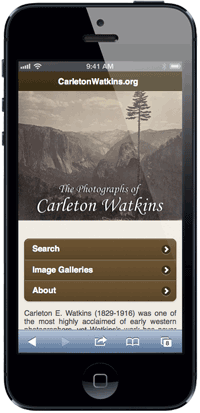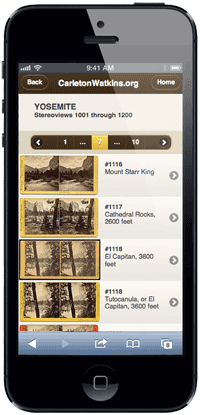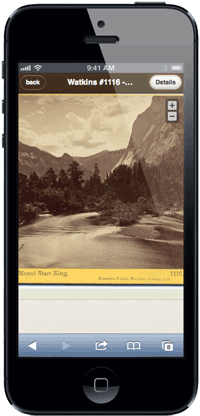
Your search results will show matches from:
Searches are not case sensitive. Searching for san francisco is the same as San Francisco.


Watkins is best known for his mammoth print photographs of Yosemite, however the greatest number of surviving prints are in the stereograph format. Watins also produced photographs in several other sizes.
Typically 18 by 22 inches. Before the development of photographic enlargers images were contact printed from the glass plate negative. Watkins used a specially constructed mammoth plate camera to create large format prints with very fine details.
Two photographic prints mounted side by side on a 3 by 7 inch card. Viewed through a stereoscope they appear as a single 3-D image with the depth of the original scene. Watkins made an estimated four to five thousand stereographs during his career. Stereographs were an extremely popular photography format in America from the 1850's through the 1930's.
Approx 5-3/8 by 8-3/8 inches. These prints were primarily made from Watkins New Series negatives.
Watkins produced photographs with a number of intermediate print sizes such as a series of 8 by 10 inch prints of Kern County argicultural subjects taken in 1888.
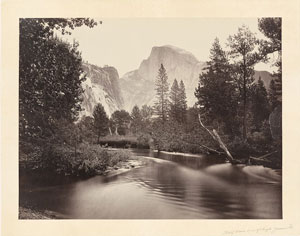 Mammoth Plate
Mammoth Plate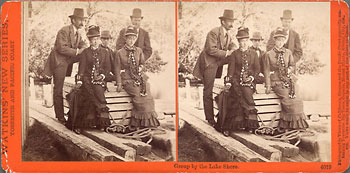 Stereograph
Stereograph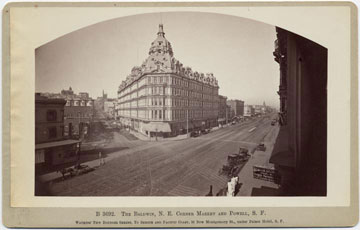 New Boudoir Series
New Boudoir Series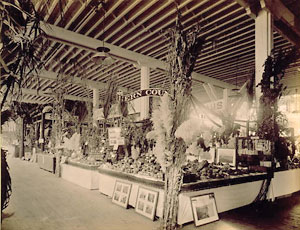 #287 - Kern County products, Kern County exhibit
#287 - Kern County products, Kern County exhibit(Examples are not to scale)
Watkins typically titled and numbered his photographs. Earlier prints have handwritten titles while later prints were given imprinted titles. Prints are occassionally found without a title or without an assigned number. Stereographs in particular were sometimes sold with the title or number left off. Apparently certain series of images were never assigned numbers, such as the group photographs of the A.B. Clark orchard in Anaheim.
These photographs include Watkins' original series of views. Stereographs from this period are generally considered to be those numbered between 1 and 2800. No captions have been seen for the 2800 and 2900 series. Watkins "New Series" begins with views numbered 3000 and above and contains those images produced and published after 1875. Some Old Series negatives were also published with New Series numbers possibly using duplicate negatives.
If a title is not known it is left blank. It is possible, however, that many of the numbers were never used. Watkins may have reserved blocks of numbers and then used only a portion of them.
This list is a work in progress. Titles and images will continue to be added as they are found.
(Note: This introduction accompanied Peter Palmquist's compilation of
New Series titles, c.1982)
As the result of a financial crisis and the loss of his earlier
negatives to a creditor, Carleton Watkins started photographing anew in
the mid-1870s. Watkins "New Series" of stereoviews began with view
number 3001 and covered more than ten years of Watkins photographic
efforts.
A CHECKLIST OF C. E. WATKINS' STEREOSCOPIC VIEWS - NEW SERIES
by Peter E. Palmquist
Most collectors of Western stereographs are avid admirers of Watkins's early work. Frequently, however, his NEW SERIES output is not always so highly regarded. It has been suggested that his new series work is of late origin and produced after Watkins had reached his prime. In point of fact, Watkins's New Series stereographs are of inestimatable historic value. Some are the earliest known views of Southern California, Washington Territory, and other areas of the Pacific Coast. His views of Nevada and Arizona are also exceptional in this regard. Subject wise, the new series contains invaluable records of all kinds of pioneer industries, the onset of tourist development, and the growth of the rural West generally. Artistically, the new series clearly reflects Watkins's professional maturity and includes many of his finest images. Moreover, with the exception of certain Yosemite images and some of the more popular San Francisco views, new series stereographs are often very scarce. Views numbering above #5000, for example, are exceedingly difficult to locate. Hopefully, the following observations and attached checklist will stimulate collector interest and lead to a better appreciation of WATKINS' NEW SERIES stereographs as an outstanding and rewarding collecting area.
WATKINS' NEW SERIES STEREOGRAPHS ARE THOUGHT TO CONFORM TO THE FOLLOWING CRITERIA
1) PRODUCTION
Generally, Watkins's NEW SERIES stereographs should be considered as
those images produced and published after 1875. The new series was
issued because Watkins lost-through financial difficulties-a large
number of his early view negatives to a competitor. The principal body
of new series stereographs are numbered between #3000 and #5300.
However, views numbering under #3000 exist, and it is probable that
they were "Old Series" survivors published after 1875. Some new series
stereographs which number between #3000-5300 are known to be reprints
of old series negatives which have been reissued. For instance, the
Utah views, #4701-4716 taken in 1873-74, had once been issued as
"Watkins' Union Pacific Railroad" series. Conversely, a very small
number of old series stereographs exist with numberation exceeding
#3000. It should be noted that many of Watkins's New Series
stereographs were made from the same negative also used to produce
boudoir and cabinet size images; titling is not identical, however.
2) PUBLISHING
Stereographs bearing the logo "Watkins' New Series, Yosemite and
Pacific Coast / 26 Montgomery Street, and Woodward's Gardens, S.F."
were published between 1876 and 1879. Views bearing the logo "Watkins'
New Series of Pacific Coast Views, 427 Montgomery Street, S.F. /
Photographic Views of California, Oregon, Nevada, Arizona, Lower Cal.,
and the Pacific Coast..." were published by Watkins between 1879 and
1890. All views are on orange mounts with lavender backs.
3) THE "E" SERIES
In 1884-85 Watkins made a special trip along the Oregon railroad into
Idaho and Wyoming as far as Yellowstone. He issued stereographs from
this journey on new series mounts, but with a special numbering:
Oregon, #E-l through E-53; Idaho E-100+; Yellowstone E-200+.
The following checklist of WATKINS' NEW SERIES stereographs have been drawn from many sources, including two of Watkins's published listings: Watkins' New Series Stereoscopic Views of Southern California and S.P.R.R. of Arizona and Watkins' Stereoscopic Views of Southern California, S.P.R.R., the Old Missions, Etc., Etc. Also consulted was Charles Beebe Turrill's "Catalogue-Watkins' Stereoscopic Views, New Series," compiled in 1918. Turrill, who had befriended Watkins a few years before the photographer's death, made his list according to subject content rather than specifically by title. In addition, I have been helped by many collectors; particularly Wally Beardsley, Marilyn Blaisdell, Louis Smaus, Larry Moskovitz and the staff of the California State Library-Gary Kurutz, Richard Terry, and Teresa Bodine. Titles listed are as complete as possible. It must be remembered, however, that variations in Watkins's titles exist, primarily at times of reprinting. Thus, minor differences between actual cards and this list are inevitable. In some instances, an educated guess has been made for certain titles which have not been verified: i.e. in the case where titles proceeding and following a missing title are known to be the same. In cases where only the subject content is known, the title is not followed by a period. Missing numbers within the new series are presumed not to have been issued. Because this is a listing "in progress" your suggested additions and corrections are solicited.
CarletonWatkins.org includes images made by other photographers as well as images published under other names. It was a common practice at that time for negatives to be purchased by another photographer or publisher and sold under their name without crediting the original photographer. Where possible we include all variations of an image on the website. There are sometimes differences in titles or interesting differences in cropping that reveal additional details of an image. Here are several examples:
As a result of the financial panic of 1873 Waktins lost control of his "Old Series" negatives to creditor J.J. Cook. The negatives passed to San Francisco photographer I.W. Taber who published them under his own name without credit to Watkins. The Taber prints generally kept the same titles as Watkins. There are occasional differences in cropping of the images.
The Modoc War (northeastern California) was photographed by Heller in 1873. Although he originally published stereographs under his own name, the images were soon being published by Watkins without credit to Heller. <include a thumbnail>
Hart photographed the Central Pacific Railroad from 1864-1869 during construction of the transcontinental route from Sacramento to Promontory Point, Utah. Hart published 365 stereographic images during that time however after 1869 the negatives were published by Watkins. In addition, at various times before being acquired by Watkins some images were published by the firm of Whitney and Paradise as well as by Durgan. The website includes examples of each were available. Many images from the different publishers have variations in cropping.
A series of images taken in the geyser region of Sonoma County were published by Watkins, Edweard Muybridge and J.G. Brayton. The images are identical and were clearly made from a single exposure.
Some features of CarletonWatkins.org require that Javascript is enabled. They are features that enhance usability and most features of the website can be used with or without Javascript. Browsers usually have Javascript enabled by default. If your browser does not have Javascript enabled you will see a warning message at the top of the home page.

Here are instructions to enable JavaScript in your web browser.
CarletonWatkins.org has a navigation menu at the top of each page allowing you to quickly move throughout the website. Menu options such as Featured Photographs and the image galleries drop down from a menu bar as you hover over each selection. Clicking on a selection will then take you to that page.
Images are grouped into galleries which are reached from the navigation menus. Image galleries are organized according to the photographers series such as 1861-1874 (Watkins Old Series) and 1875-1890 (Watkins New Series). As illustruated here, you can hover over one of the series selections and then hover over one of the gallery names. A gallery preview will appear with each gallery including a sample image and information about the contents of the gallery.
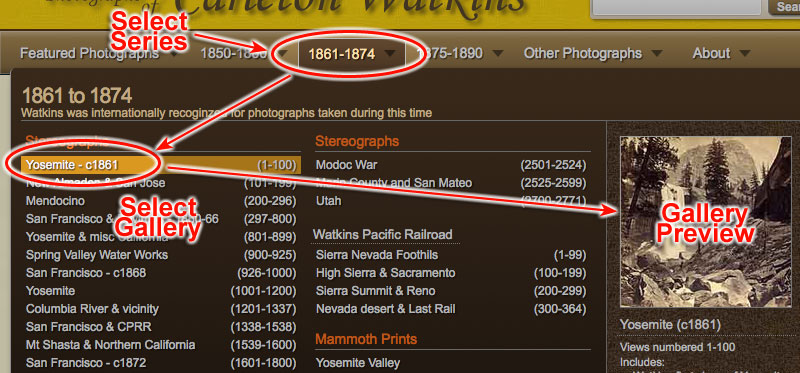
Image galleries contain photographs grouped by subject or by the photographers series.
When you go to one of the galleries or perform a search there are several options for viewing the images.

The upper right corner of each page contains a search box that can be used to find images on CarletonWatkins.org.
Your search results will show matches from:
Searches are not case sensitive. Searching for san francisco is the same as San Francisco.
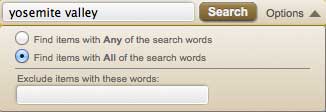
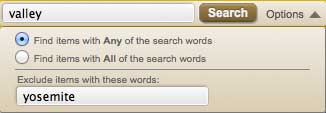
The search results will display all formats, photographers and publishers found in the search. Each one will be shown with a checkbox.
Use the check boxes to narrow the selection by checking or unchecking as desired. Click on the "Filter Results" button to filter the results.

Note: Entering new search words and clicking "Search" will reset the filters.
Search results can be sorted and displayed in either a list or grid format by choosing from the options shown above the search results.


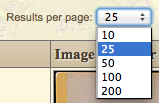

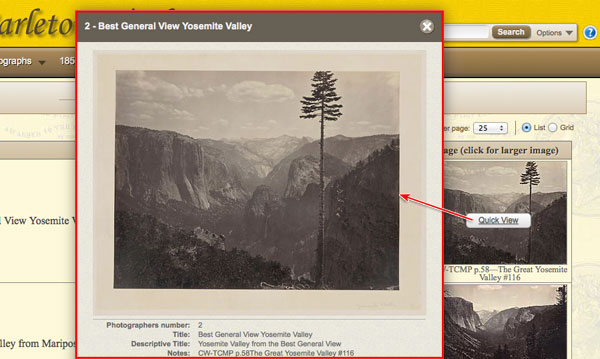 Use Quick View to see detailed information about an image without
leaving the page. When you hover over a thumbnail image with
your cursor a Quick View
button appears. Click on the button to display the Quick
View pane.
Use Quick View to see detailed information about an image without
leaving the page. When you hover over a thumbnail image with
your cursor a Quick View
button appears. Click on the button to display the Quick
View pane.
 When you click on the thumbnail without clicking on the Quick View
button a larger 'full size' image will be displayed in a new
page. See Displaying larger images and detailed information
When you click on the thumbnail without clicking on the Quick View
button a larger 'full size' image will be displayed in a new
page. See Displaying larger images and detailed information
Clicking on an image thumbnail opens a new page with a larger image and more detailed information about the image. Any available details are listed below the image.
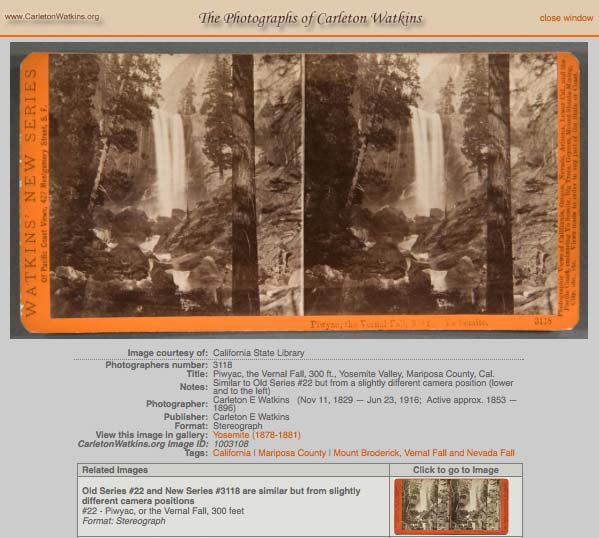
Any related images are displayed below the list of image details. Clicking the thumbnail of the related image will open a new page with that image. The reason the images are related is listed next to the thumbnail.
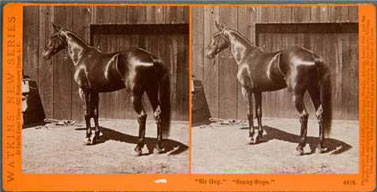
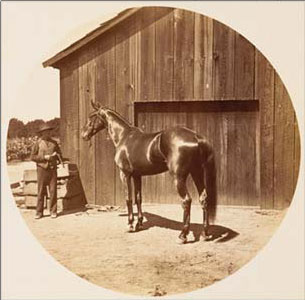 5" circular print - Sunny Slope, San Gabriel Album
5" circular print - Sunny Slope, San Gabriel AlbumTags are like keywords or labels added to images having something in common. Tags may refer to subjects, locations, regions, people, styles or other concepts. Clicking on a tag will display all images with that tag. Each image may have other tags as well. This allows an alternate navigation by moving from one group of tagged images to another. Most images on CarletonWatkins.org have one or more tags.
Some typical tags are:
In this example images with the tag "Mill" are shown. Each image has all its tags listed below the title. Clicking on one of the tags will display all images with that tag. Click here to browse tags.
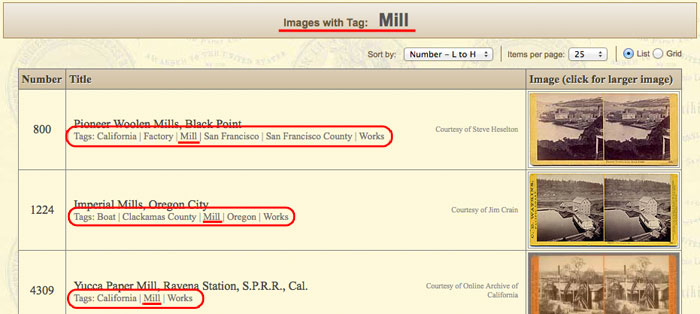
On mobile devices you can search for images and browse image galleries as well as viewing details and information about an image.
